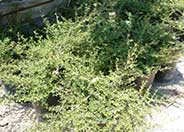
Common name:Morning Light Silver Grass
Botanical name:Miscanthus sinensis 'Morning Light'
The 'Morning Light' is also a taller variety, growing to 6'-8' tall with delicate feathery plumes and very thin graceful leaves. This is a variegated form. It should receive sun to part shade, and average to little summer watering. Tall grasses are highly combustible.

Common name:Creeping Mirror Plant
Botanical name:Coprosma X kirkii
This spreading evergreen shrub grows 1'-3' high and 2'-5' wide with small glossy leaves. It tolerates clay soils, mild drought situations, and wind.

Common name:Hybrid White Rockrose
Botanical name:Cistus X hybridus
This is a small evergreen shrub with 2" long gray green, crinkly leaves. It has pure white flowers with prominent yellow stamens. It flowers throughout the spring to early summer. Avoid heavy mulches.
.

Common name:New Zealand Flax
Botanical name:Phormium tenax
New Zealand Flax is a large, bold plant with stiffly vertical, sword-like, green leaves that arise from its base. It should be grown under full sun for best color. Varieties will offer different growth habits and leaf color.
Maintenance Tips
Phormium tenax is a perennial that grows as a clump with strap-like leaves. This is a very popular plant and has many different hybrids that are selected for their different foliage colors, sizes, and textures. When growing this species, there is a lot of genetic variety, so the size of the mature plant can range from 2' up to 8'. To keep the maintenance as low as possible, plant in a location that is full sun, and well-drained and give it the space it needs to reach maturity. These plants are often the victim of poor pruning habits, with gardeners cutting the leaves off in the middle or shearing them because they are too large for the space they have been given. If this is the case, they should be transplanted to a location where they can reach their full size, or other plants around them should be moved out of their way.
Photographer: GardenSoft
Physical weed control, including mulching, or hand removal protects the watershed from harmful chemicals.
Be sure to fix all leaks promptly no matter how small they may seem.
Drip and other smart irrigation delivers water directly to roots, allowing no excess water for weeds.